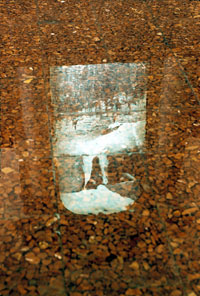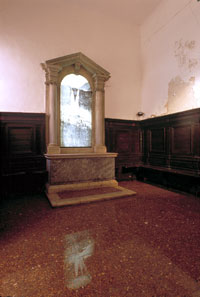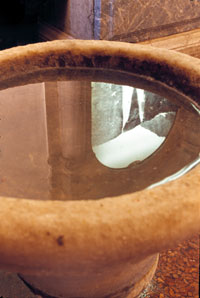What could be more appropriate, in the middle of the Earth summit in Johannesburg, than to exhibit an image of the most important and discussed of life’s elements, water? Scientists tell us that by the 2030 the biggest emergency on our planet will be the water shortage. Water, without which life on earth is impossible, will soon become the most precious resource to preserve; if not we perish.
Alistair Wilson, a Welsh artist living in Belfast, celebrates the beauty and the strengths of water, installing his work in Venice, the city that on has built its entire history on water. This he does with apparent simplicity and innocence, giving us many possibilities and levels of interpretation.
The installation consists of an old photographic image reproduced on Perspex, which is lit from behind and cut to fit the arched altar of the oratory San Ludovico. Traditionally, we would see a religious painting in the same position.
This idea, to exhibit contemporary art in historical spaces like old museums or churches, has been enabled by the director of the Nuova Icona gallery, Vittorio Urbani, who has for many years been involved in promoting international art in Venice. Showing modern art in ancient building which are dedicated to spirituality puts artists in a delicate position, one with certain responsibilities. Their art in this context stops belonging only to their time, but links itself to the history of humanity; this demands from artists that they measure their ideas for a particular environment in constant respect to its already existing content.
Wilson came to terms with his task in full comprehension of the implications that the oratory space involves. He had approached his installation formally and with apparent detachment, but not without awareness that the many layers of history around his work will speak for themselves and will add to it many dimensions.
| |||||
| The photographic image represents a waterfall in Canada. Two lines of water fall from considerable height, joining into one stream behind the tops of fir trees. The artist continues its fall, flooding the floor of the church, making water become a physical reality. This floor, like many other floors in Venice, will soon be flooded naturally many times over and over again.
The water image on the church altar could represent Nature in its most essential form. But there is another reading to the installation, which has to do with the origin of the photograph. The photo is enlarged from an early transparency on glass, dating to around the turn of the 20th century. It was intended at that time to stimulate the Irish population to emigrate to Canada. During Victorian times many young, strong men, usually single, were emigrating, with the hope of bettering their lives but often also with a pure desire for adventure. I would presume that the image that Wilson has chosen for his artwork was originally directed at these young men. The photo was meant to seduce them, as it seduced the artist, appealing to their sense of free spirit through the representation of the wild beauty of Canadian nature. What could be more seductive and beautiful than a clean, powerful stream of water hitting the rocks with force, spilling its transparent matter all over the severe landscape so different to the gentle, green countryside of their native Ireland? Sonia Rolak is an artist, curator and art critic based in Venice. Alistair Wilson is the first artist to benefit from the new exchange programme initiated jointly by Nuova Icona, Venice, and Queen’s University, Belfast; more information here . Nuova Icona has consistently assisted with the Republic’s representation at the Venice Biennale; more on the Republic’s representation here . | |||||


